Heart eyes for heartleaf skullcap and more
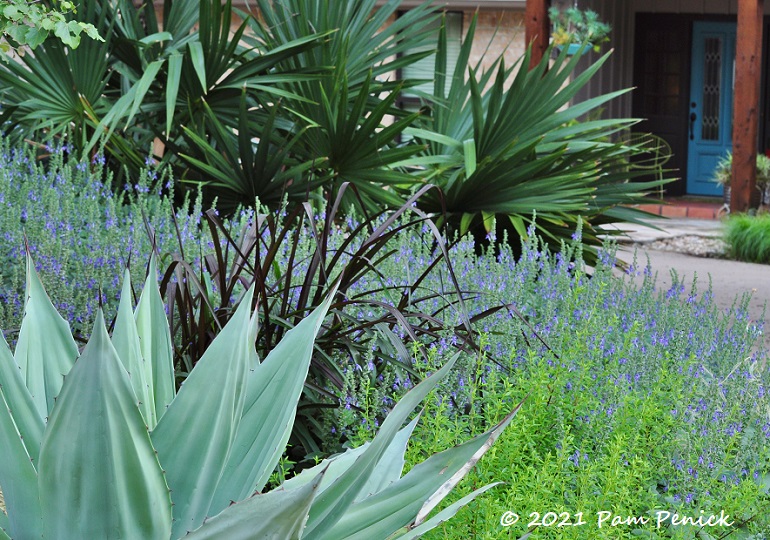
A blue haze has settled over the driveway-island bed, the silvery blue flowers of heartleaf skullcap (Scutellaria ovata). I find myself stopping to admire them every time I step outside.
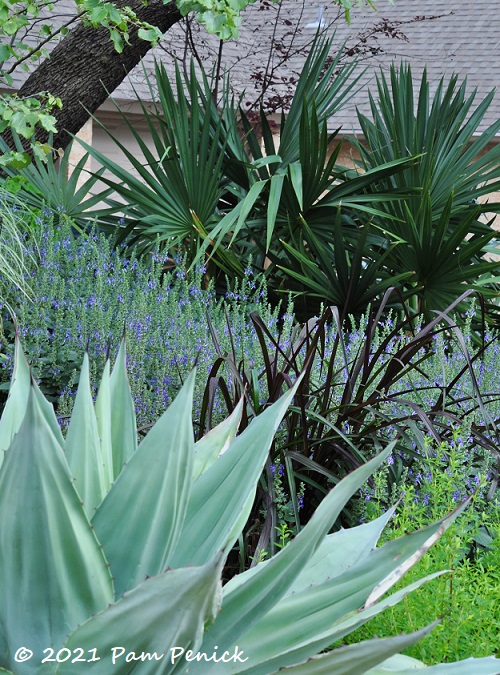
It fills in nicely around a ‘Vanzie’ whale’s tongue agave (Agave ovatifolia), ‘Vertigo’ pennisetum grass, Mexican oregano (Poliomintha longiflora), and Texas dwarf palmetto (Sabal minor), all of which grow in bright shade.
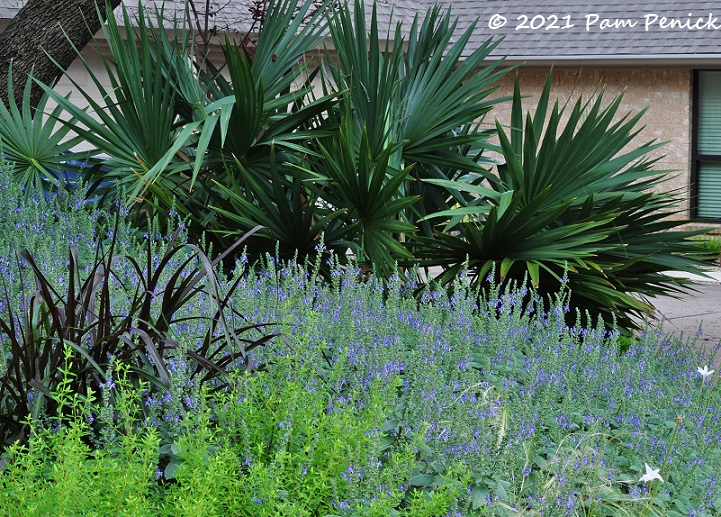
A sprinkling of native white rain lilies (Cooperia pedunculata) popped up after the rain, adding their fragrant, starry blossoms to the scene. When the flowers fade and black seeds appear in the dried capsule, I flick them up onto the bermed bed to make more.
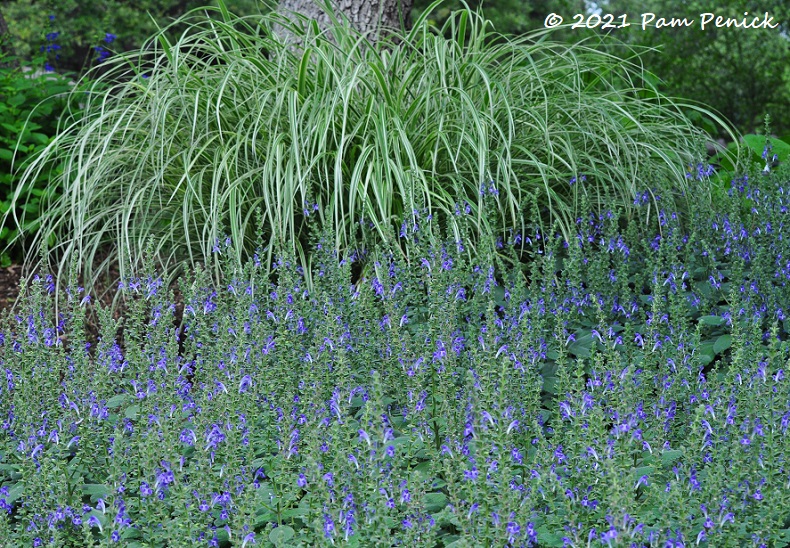
Heartleaf skullcap looks especially pretty paired with fresh green-and-white stripes — in this case, a variegated miscanthus grass. ‘Sparkler’ sedge and variegated flax lily also work well.
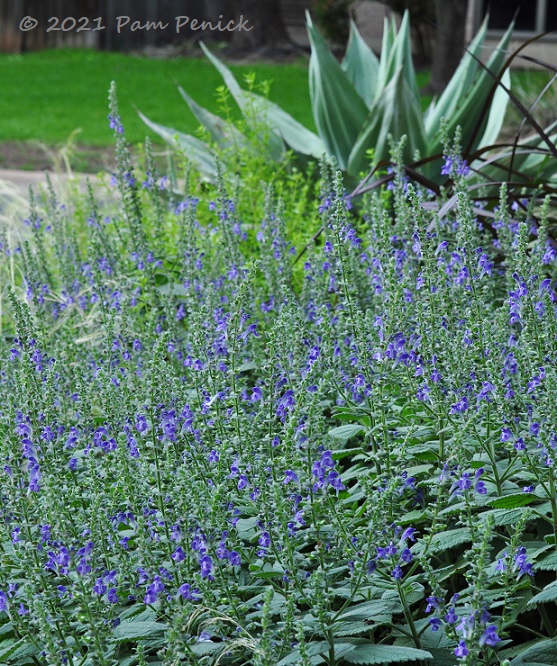
Heartleaf skullcap sticks around from winter (as a pretty, blue-green groundcover) through May, and then it goes dormant for summer. Smart plant. Turk’s cap fills most of the gap in summer.
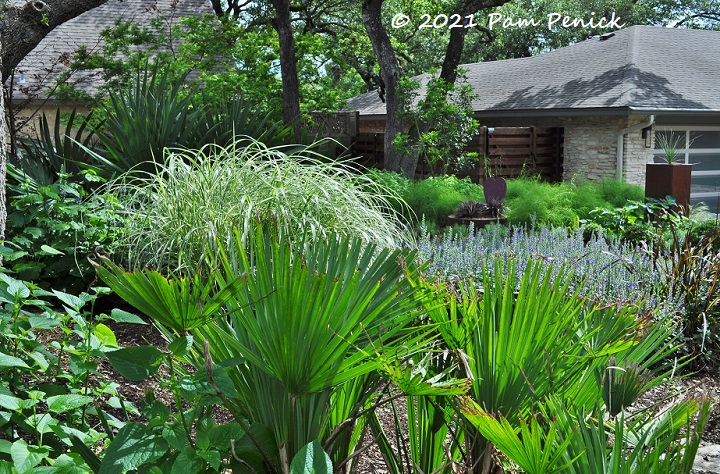
After taking a hit in the February freeze, the garden is now growing like mad. No doubt a late-winter application of compost — something I don’t do often enough — is helping. Even the silver Mediterranean fan palm (Chamaerops humilis var. argentea), a plant I wasn’t sure would survive, is stretching higher with new fringy fronds.
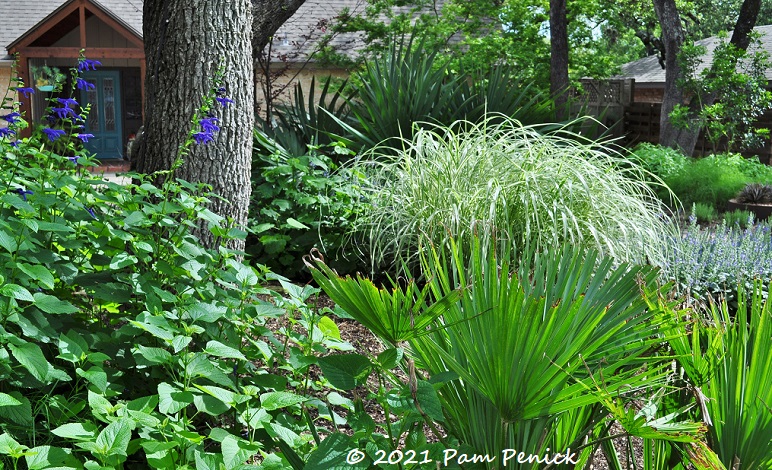
Salvia guaranitica adds cobalt flower spikes to the mix.
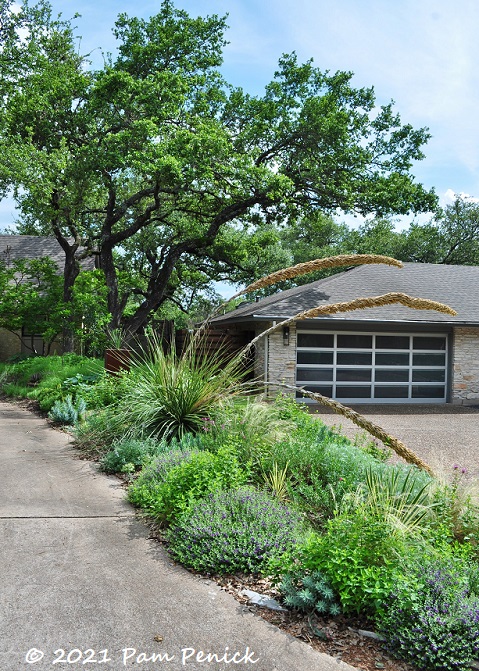
The Texas sotol (Dasylirion texana) bloom spikes flopped waaaaay over during the recent heavy rains. I cut off the lowest one this morning, as it was laying in the neighbors’ driveway. The other two are trying to stand back up. The bees loved them when they first opened, but there’s less action now.
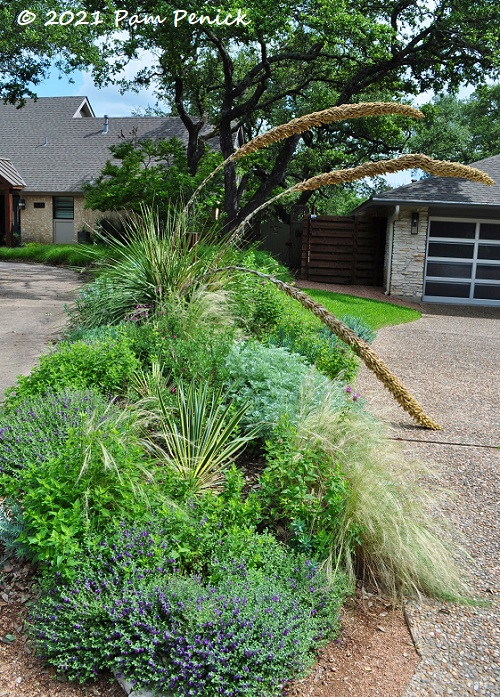
Purple skullcap’s tidy mound of foliage (Scutellaria wrightii) sprinkled with violet flowers looks great and stands up to innumerable dogs lifting their legs on it. Soon ‘Peter’s Purple’ monarda will be blooming here too.
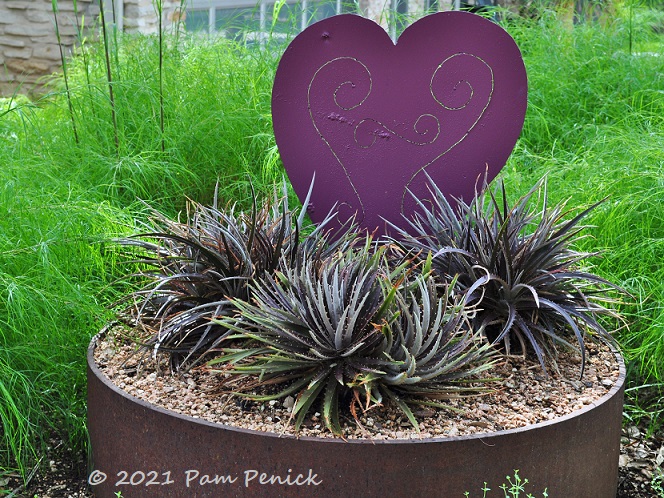
Bamboo muhly (Muhlenbergia dumosa), the bright-green grass in the background, is coming back strong from its roots. A lethally spiky trio of replanted ‘Burgundy Ice’ dyckia occupies a steel-pipe throne.
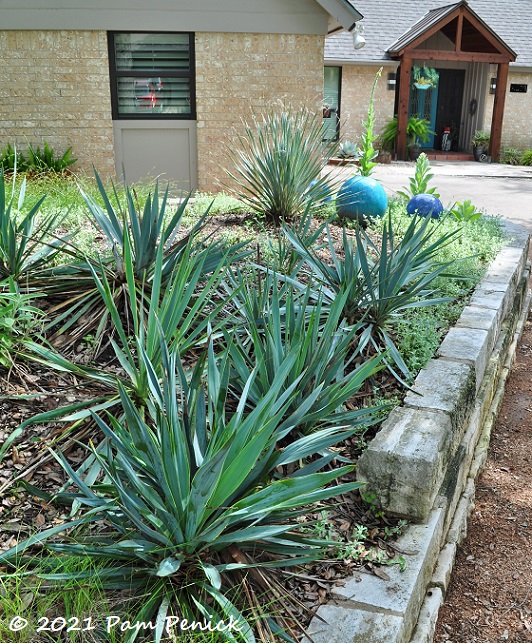
On the other side of the driveway, this space is now officially a turquoise garden. A grid of paleleaf yuccas (Y. pallida) coexist with a new powder-blue wheeler’s sotol (Dasylirion wheeleri), which replaced a freeze-melted ‘Green Goblet’ agave. Filling back in as a groundcover is woolly stemodia (Stemodia lanata). Ceramic balls in shades of blue lead the eye to the turquoise front door.
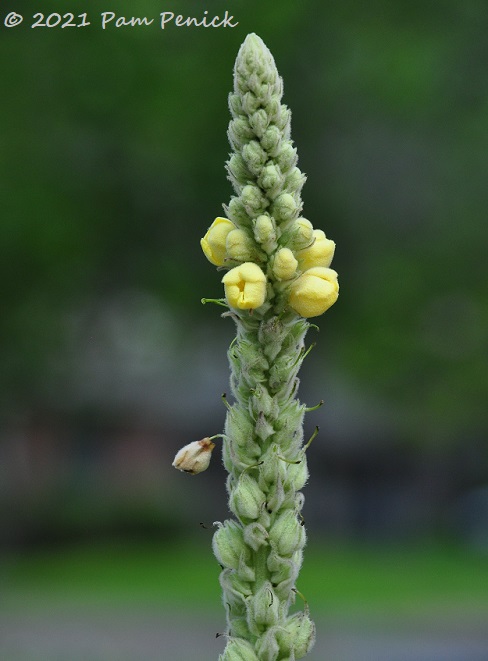
Mullein passalongs (Verbascum spp.) from my friend Jenny at Rock Rose blog have started blooming.
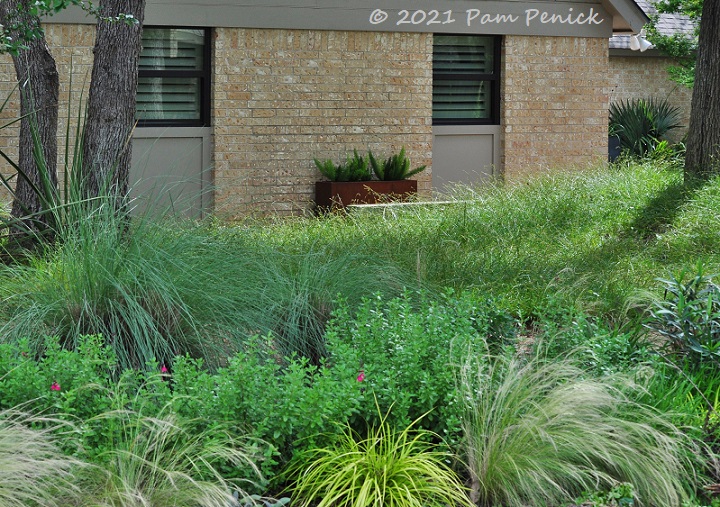
And oh boy!, so has the Berkeley sedge (Carex divulsa) lawnette. It’s taller than ever and sparkling with seedheads in the background of this photo. I confess it started looking weedy even to me. So I got out the battery-operated mower and made a couple of passes over it this week. It’s my once-a-year mow. Actually it’s pretty satisfying to turn the meadowy sedge into a mown lawn (but not for heavy foot traffic).
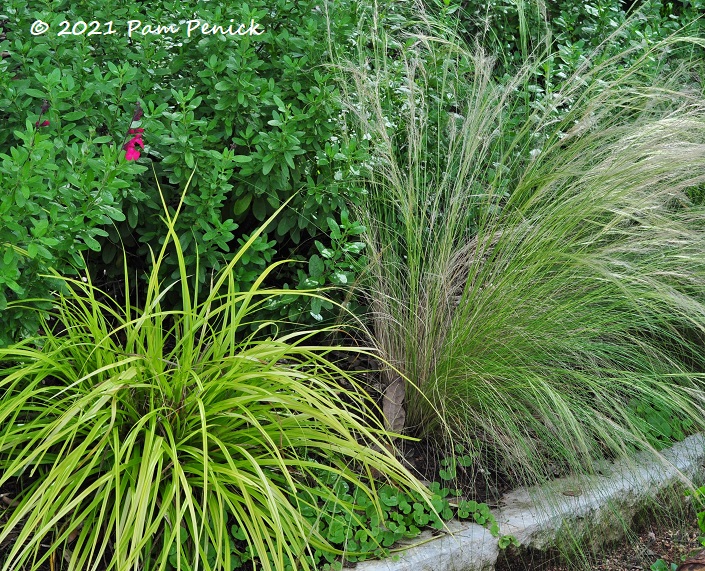
I don’t know what’s going on here. An experiment, I guess! I had a few extra ‘Everillo’ sedges before the big freeze and plunked them into the curbside strip for a bit of winter color. And now Mexican feathergrass has popped up next to them, creating a strange forest-meets-grasslands look. Well, that’s OK. I’m playing with ‘Everillo’ to see how much Texas sun and dry soil it can tolerate. So far it’s been much more adaptable than I expected for such a Pacific Northwest-looking plant.
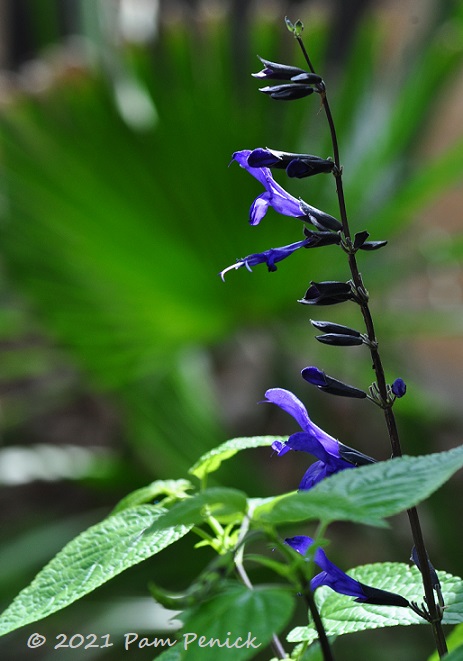
Salvia guaranitica, probably the ‘Black and Blue’ cultivar, looks so pretty in the shady garden.
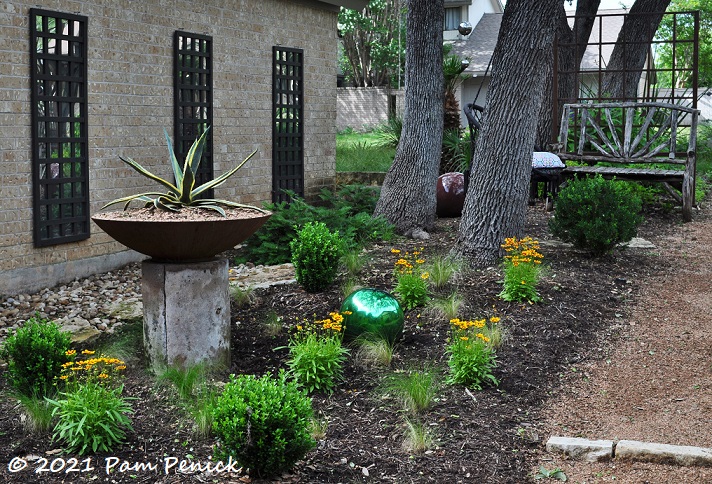
The side garden is blooming nicely now that deer are leaving the UpTick coreopsis alone. Credit deer repellant for that. Which reminds me, I should go spray again after all the rain.
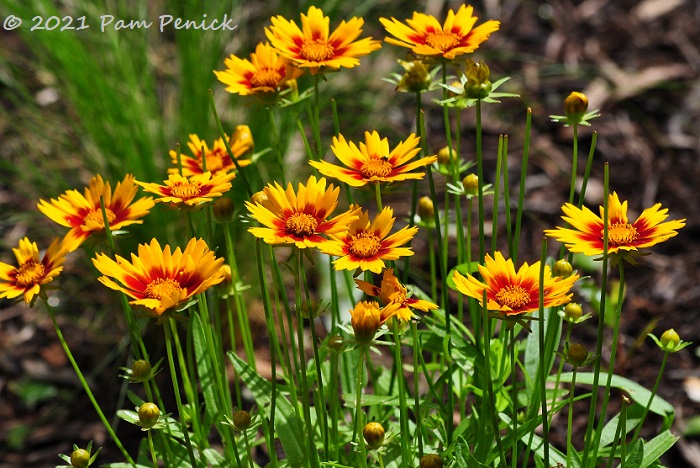
Coreopsis x ‘Baluptgonz’ is the official name, but more familiarly it’s UpTick Gold & Bronze coreopsis. I got it at one of the big-box stores earlier this spring.
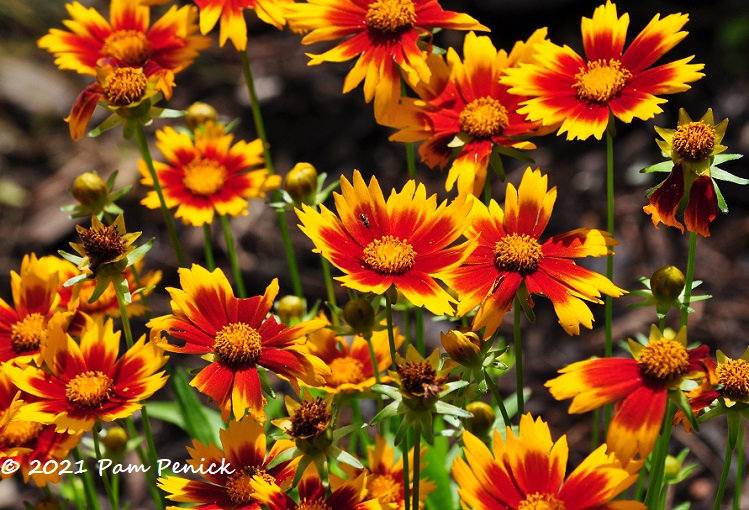
Blazing saddles!
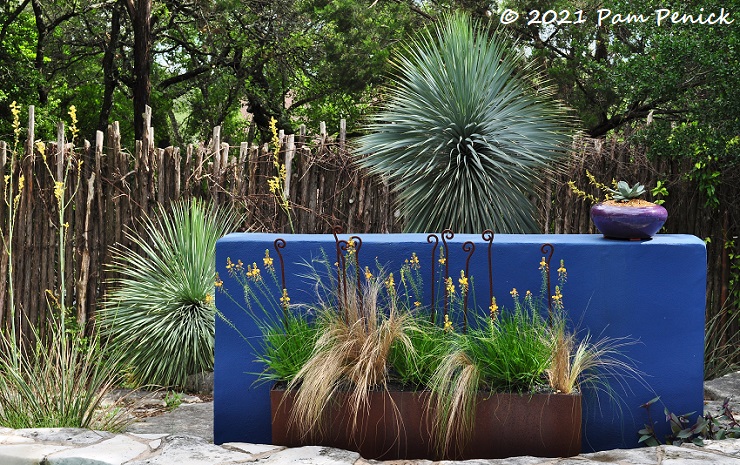
In the back garden, bulbine (replaced after the freeze) is pumping out orange-and-yellow bloom spikes. I guess I should have replaced the feathergrass too, which has a little green on it but is mostly brown. Or, I don’t know, maybe the tawny stems work with the orange flowers. Yellow-flowering red yucca (Hesperaloe parviflora) stands tall at left, but the two Yucca rostrata in back own this stage.
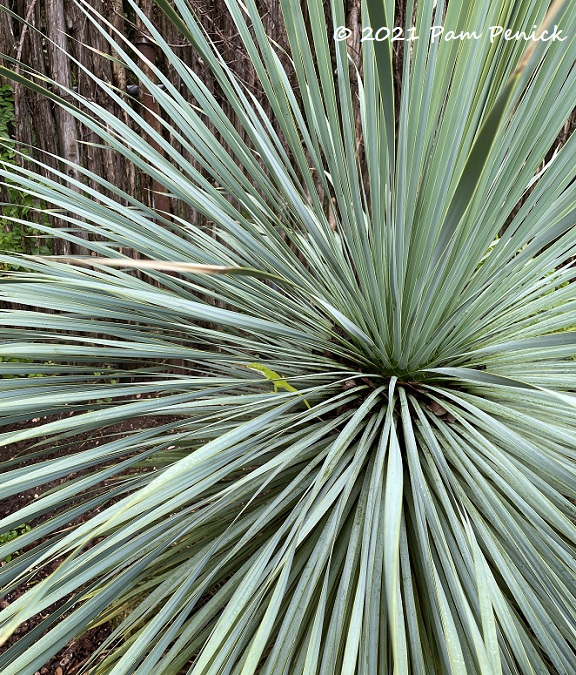
I spotted this little guy hanging out in the strappy yucca leaves yesterday.
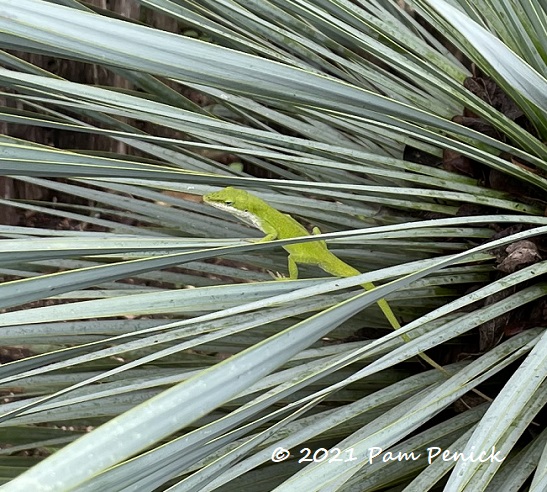
A green anole — so cute!
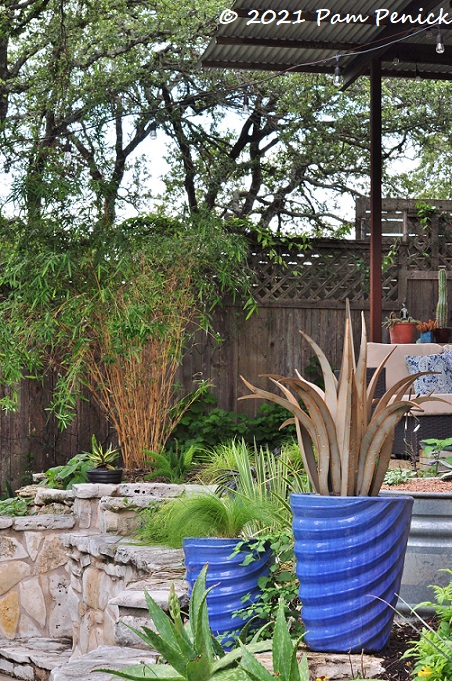
I’ve changed up the raised beds a bit since the freeze. ‘Alphonse Karr’ clumping bamboo grows where a whale’s tongue agave (including Moby) had always stood. A freeze-killed ‘Sparkler’ sedge in the big blue pot made way for a metal — aka unkillable — agave. Take that, Next Arctic Blast!
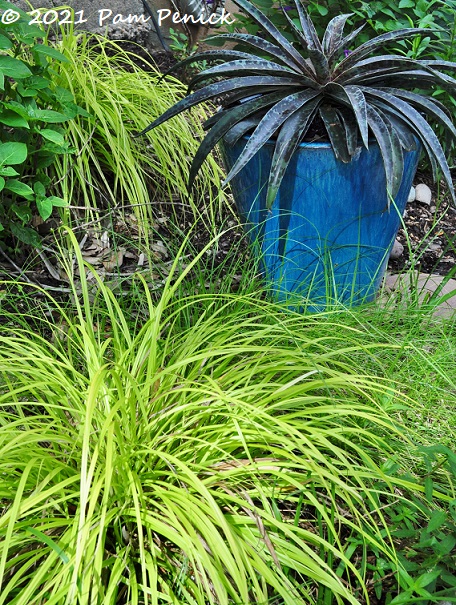
But of course I still grow freeze-tender plants. As long-season annuals, tender mangaves like this new ‘Moonglow’ make great focal points. (In a mild winter it might survive.) Its dark, speckled coloring does remind me of moonlight dappling a nighttime garden. ‘Everillo’ sedge adds a splash of sunlight.
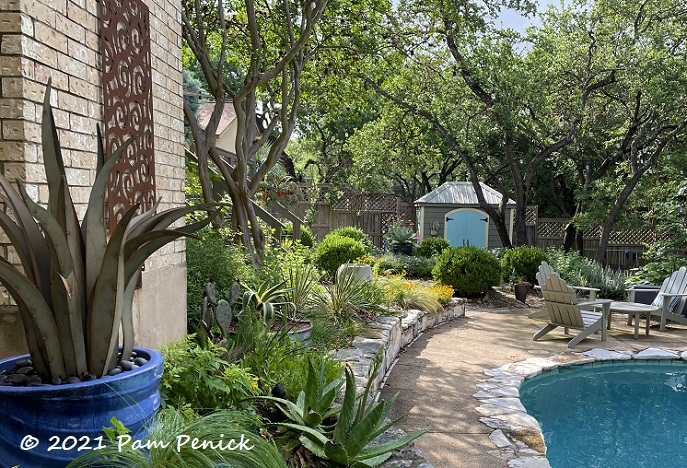
Looking the other way toward the shed
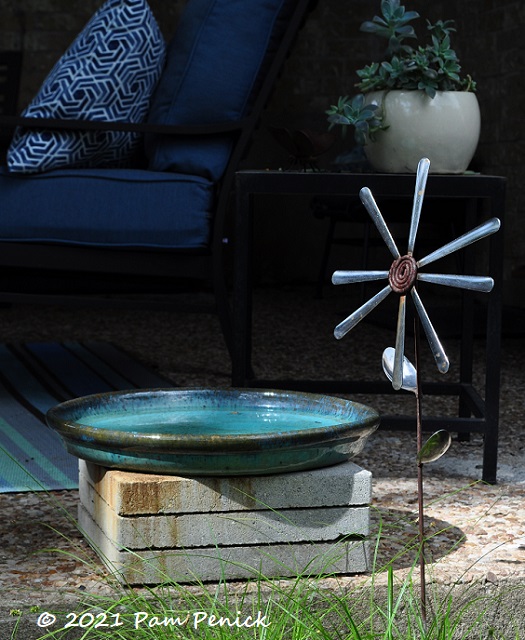
A ceramic saucer filled with water makes a simple birdbath, an idea I stole from my friend Cat’s garden. A flower of recycled knives and spoons blooms next to it.
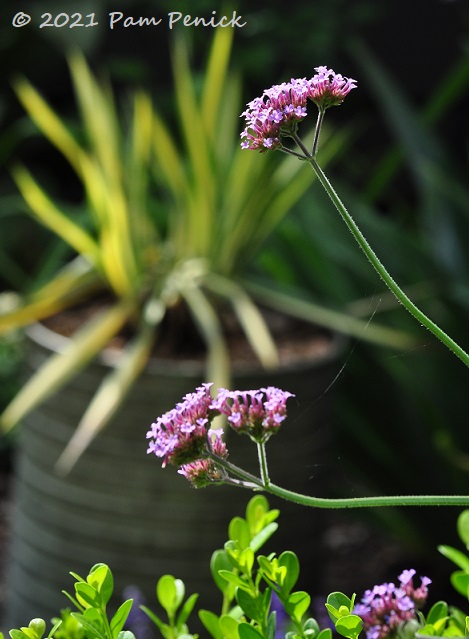
Volunteer seedlings of tall verbena (Verbena bonariensis) flower next to yellow-striped yuccas.
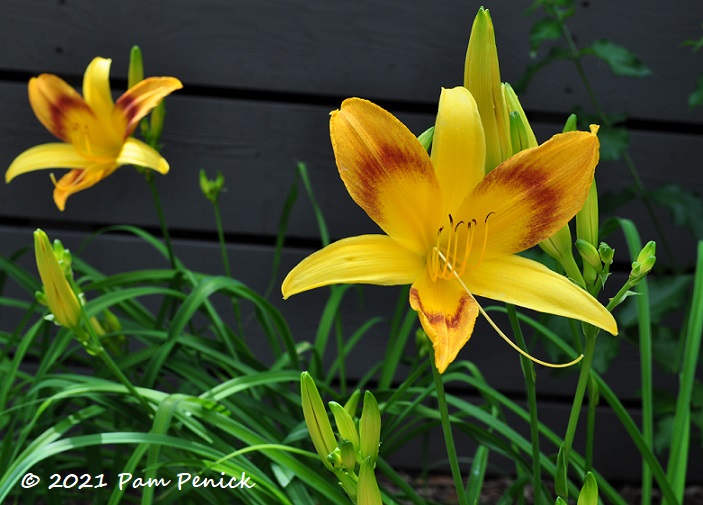
The daylilies are blooming too. This is ‘Wilson’s Yellow’, which I’ve had for 15 or 20 years and brought over from my last garden.
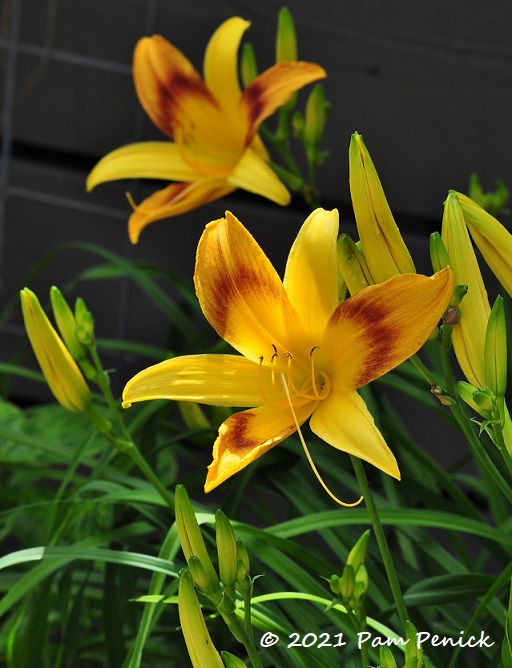
It pops against the dark-gray stain on the deck skirting.
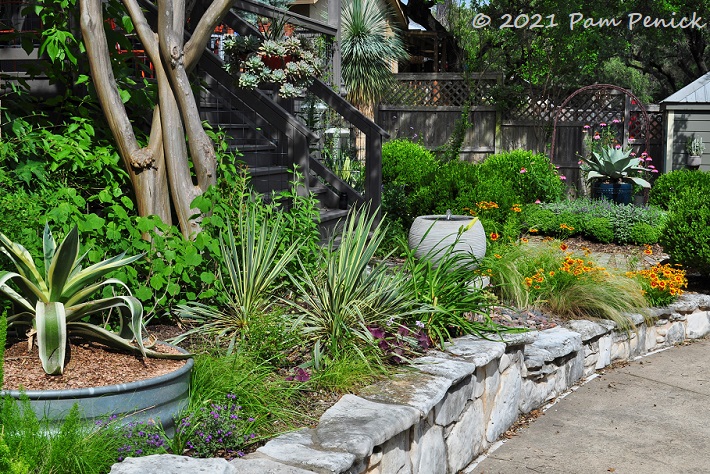
Where a squid agave froze, in the low stock tank at left, a striped ‘Espresso’ mangave now grows. I uprooted this big specimen from a shady spot when the patio roof was going up, protected it in the house during the epic freeze, and now am trying it in a good deal of sun. It seems pretty happy. By July I’ll know for sure. It came from a pup given to me years ago by designer and author Scott Ogden.
Riffing on stripes, a trio of ‘Bright Edge’ yuccas anchors a bed of come-and-go perennials, including daylily, plumbago, oxalis, ‘Grapes’ gomphrena, and pink Turk’s cap.
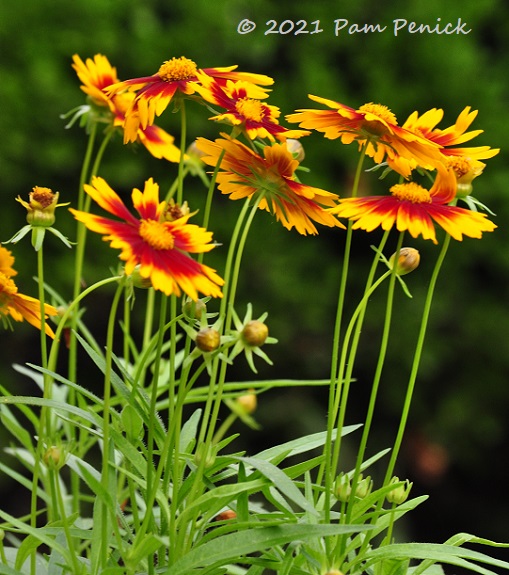
‘Sterntaler’ coreopsis grows here too. Is there any difference between ‘Sterntaler’ and UpTick, which I have in the side garden? I cannot tell them apart.
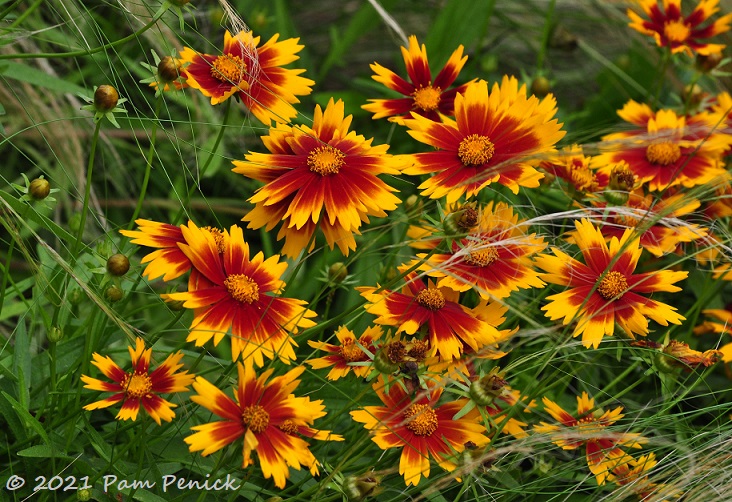
More ‘Sterntaler’
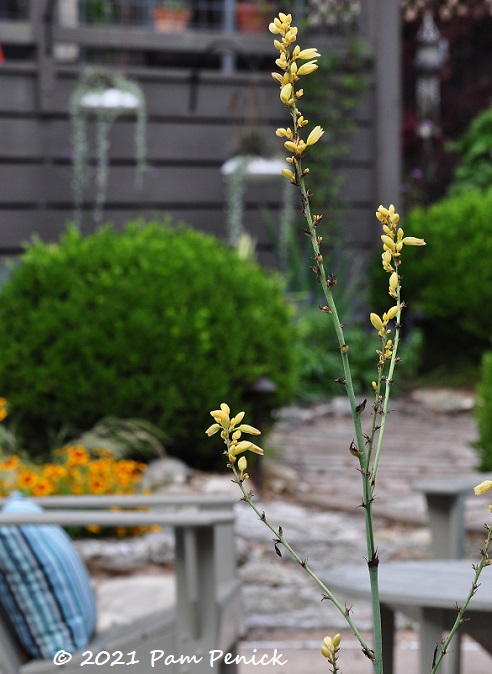
Yellow bloom spikes on the non-red yucca (Hesperaloe)
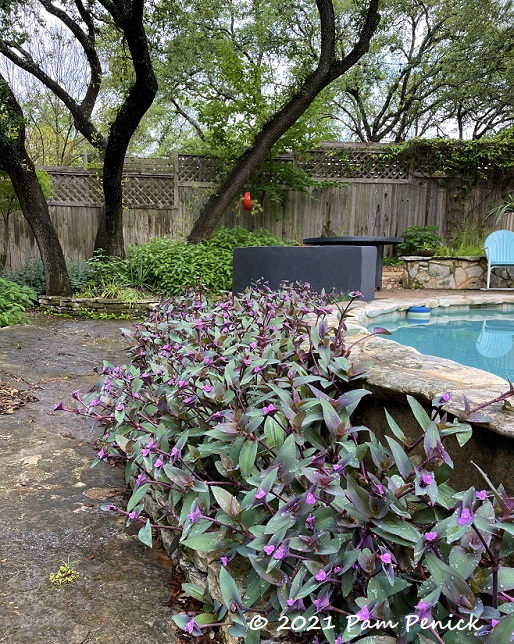
I was just telling a friend how I’ve battled for a decade to keep this patch of purple heart (Tradescantia pallida) in bounds. I love it, though, when it looks like this: a curving swath in a low bed behind the pool, its steely leaves harmonizing with the dark-gray seat wall.
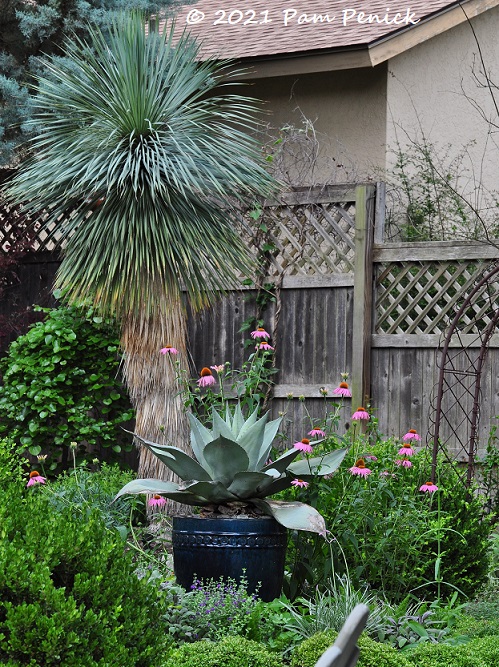
In the Circle Garden, a variegated whale’s tongue agave is still in recovery mode after the freeze, which nearly froze its moonlight-yellow stripes clean off. I’m hopeful the beautiful coloring will come back. Purple coneflowers stretch above it. Even higher, a ‘Sapphire Skies’ Yucca rostrata looms in the background.
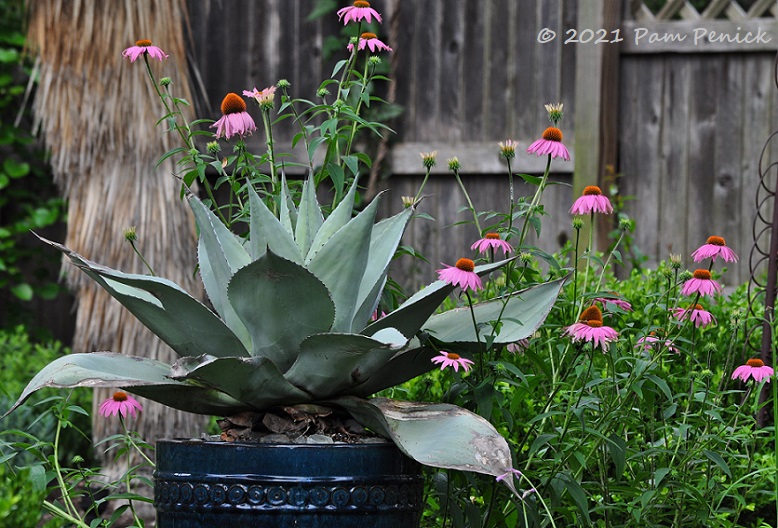
Whale’s tongue agave with purple coneflowers (Echinacea purpurea) grown from seed
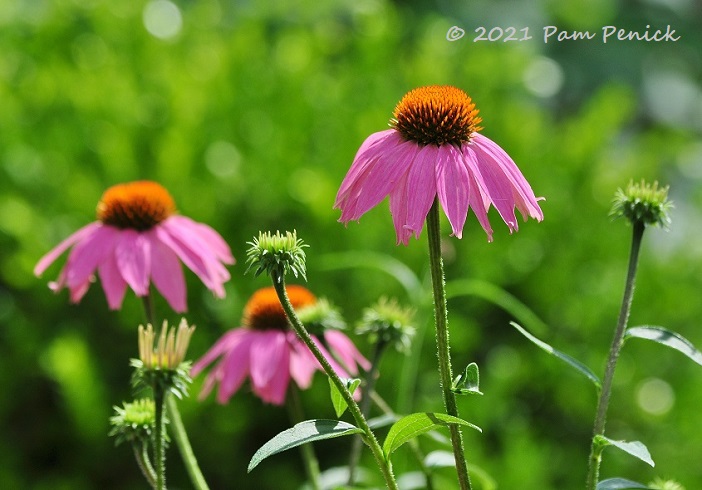
A pollinator favorite and a native Texas plant
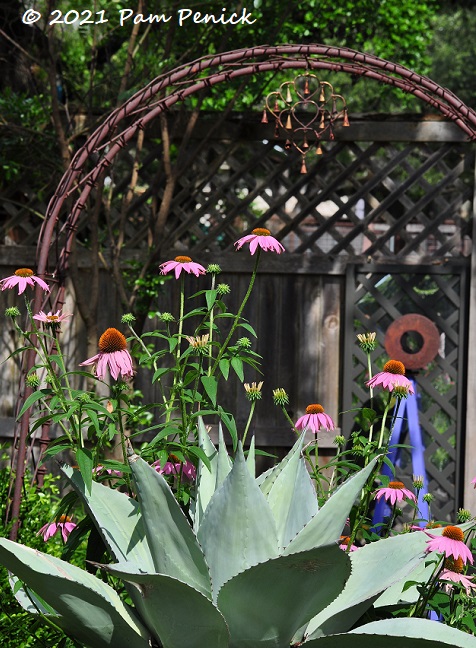
One more
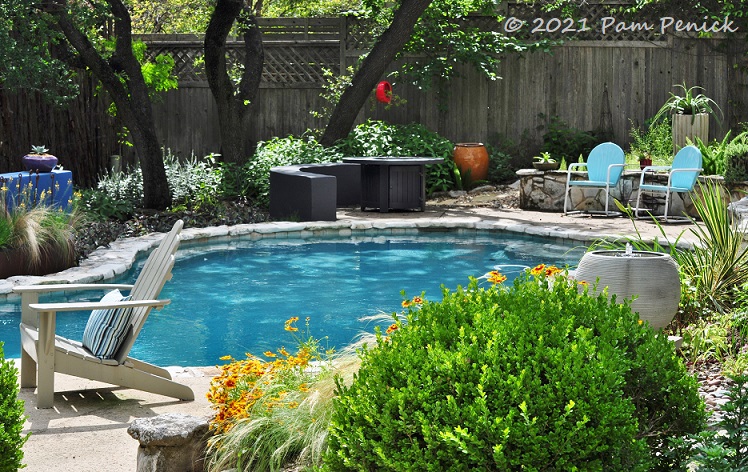
It’s pool season, but we haven’t been in it yet because of all the rain. With June upon us, though, it’s just a matter of days until this will be the place to be.
__________________________
Digging Deeper
Come learn about gardening and design at Garden Spark! I organize in-person talks by inspiring designers, landscape architects, authors, and gardeners a few times a year in Austin. These are limited-attendance events that sell out quickly, so join the Garden Spark email list to be notified in advance; simply click this link and ask to be added. Season 8 kicks off in fall 2024. Stay tuned for more info!
All material © 2025 by Pam Penick for Digging. Unauthorized reproduction prohibited.


Looking good, Pam! I think I “need” that Coreopsis.
Oh, I’m sure of it, Kris.
It looks great. That heartleaf skullcap is a keeper, and I love red and yellow flowers. Also love the vignette with the bulbine and feather grass against the blue with the yuccas as a backdrop. Other than the sotol, the rain as far as I can tell, hasn’t harmed your plants one bit.
They’ve been drinking it up. I’m grateful for a rainy May before the summer heat really arrives.
You are still the Queen of Foliage. What great combinations in every direction. I need you to stop by and give me some advice on an area that needs a re-do!
Thanks for the kind comment, Linda. Foliage is what seems to work best for me with shade and deer and months of triple digits. Flowers are a bonus.
LOL. Heartleaf skullcap and Salvia guaranitica are just two of many plants in my Dallas garden with the motto “Today the garden, tomorrow the world.”.
So true — although actually my guaranitica has never started the march here. My last garden was another story.
Would never have known you suffered the snowpocalypse (is that how it’s spelled?)! Everything is so lush— the agave and cones made my mouth water.
Re: Everillo, I’m skeptical that they will appreciate too much Texas sun combined with fast draining soil. Mine that are in clay and close to full sun have mostly died. Granted, I divided them last fall and it’s been a too-dry spring. Let us know, please.
I agree that too much sun doesn’t make them happy. I have a couple in morning to 1 pm sun, and they get a little toasty looking by midsummer. That said, with a haircut, they soon put out fresh new growth for the cooler seasons.
Your garden hardly looks as if it went through a major freeze. Excellent rebound planting.
Then my whirlwind of cleanup paid off! 😉 Thanks, Lisa.
Love the blue stucco wall with the orange bulbine and metal art!
Thanks!